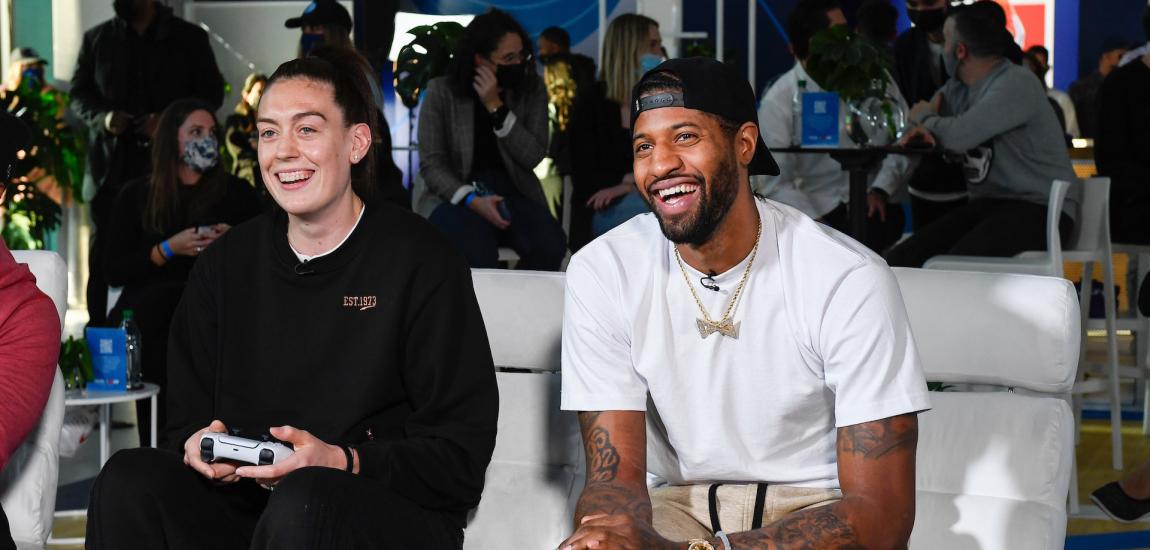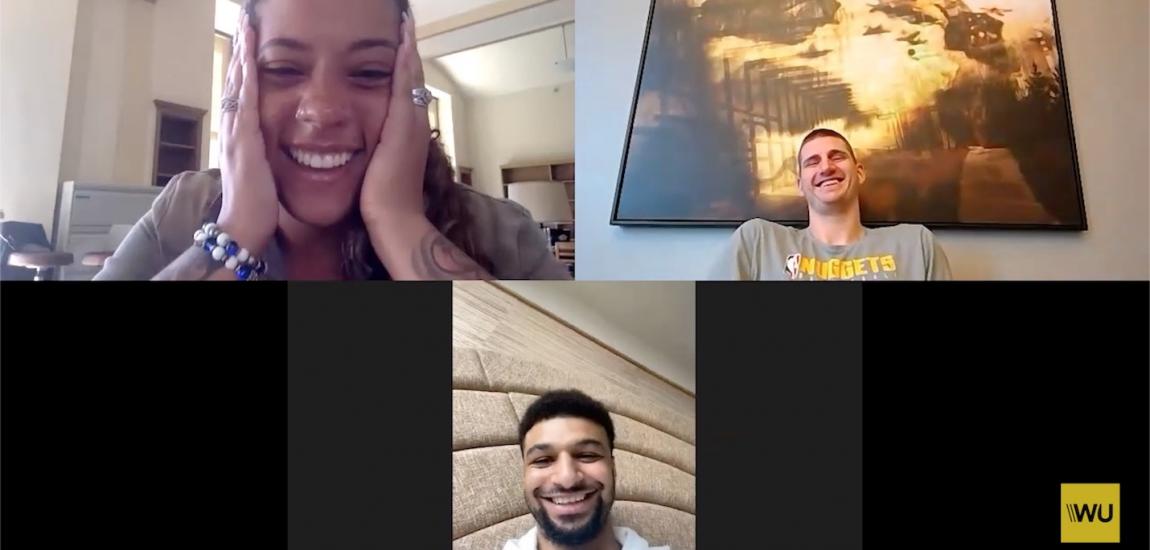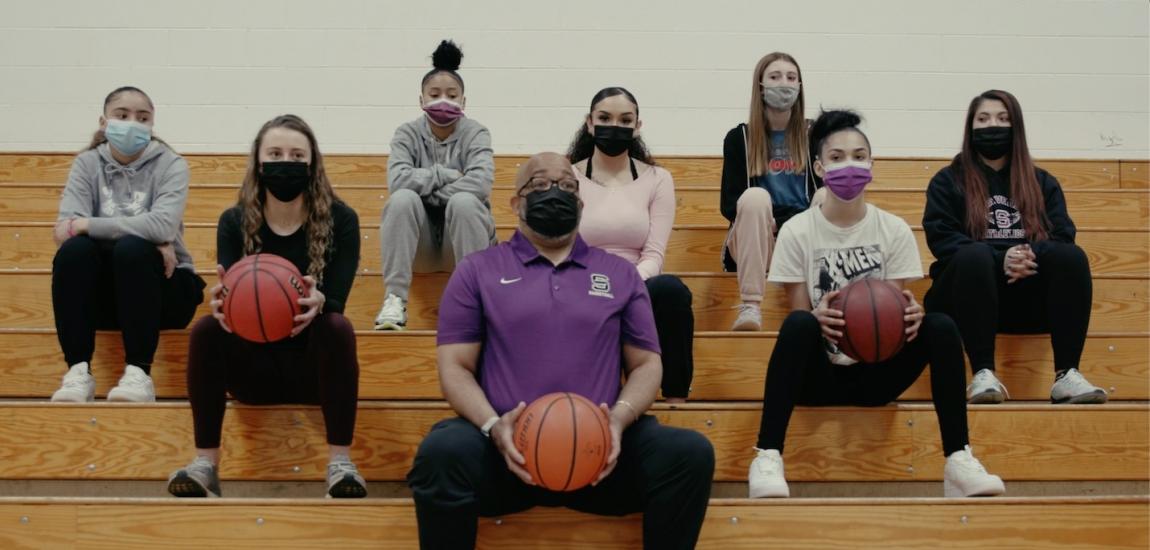A coach whose last-ditch NCAA tournament hopes hinge on winning three games in three days tells his team "it is not a freakin' option to get tired." A coach whose team is safely in the field but fighting for a higher seed watches an upset unfold on television and has 24 hours to form a game plan.
A senior sobs on the basketball court as he realizes his college career is over. A conference's top player cuts down the net in the latest chapter of his storybook senior season.
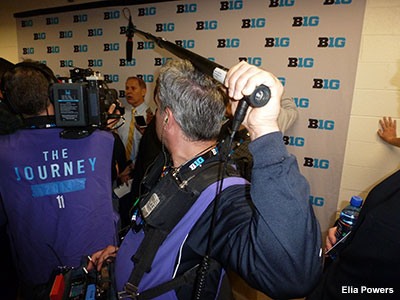
Capturing it all are cameramen wearing the broadcaster's version of basketball warmups -- sleeveless purple jackets emblazoned with "The Journey" and individualized numbers. These scenes from the Big Ten men's basketball tournament in Chicago factor prominently in the hour-long season finale of The Journey, the Big Ten Network's most-watched and critically acclaimed original series that chronicles Big Ten football and basketball.
It's easy to get lost in an increasingly crowded lineup of sports documentary programing that includes ESPN's 30 for 30 series and HBO's Hard Knocks. BTN's signature documentary program doesn't even have the market cornered on behind-the-scenes footage from this year's Big Ten Tournament -- Showtime's Hoops U followed Maryland throughout March.
The Journey has made its mark by canvassing an entire college sports conference in search of profiles that tell the story of full football and basketball seasons. It helps that the conference being profiled is known for massive alumni fan bases and just last year expanded from 12 to 14 universities, the newest of which, Maryland and Rutgers, are in the sought-after Washington, D.C. and New York media markets.
On a Friday at the Big Ten Tournament that spanned 16 hours, eight locker rooms, four games and two bubble teams, The Journey's production team discussed the show's origins, editorial philosophy, production process -- and what it's like to put together an episode that captures the spirit of March Madness.
The year after The Big Ten Conference and Fox Networks announced the creation of the Big Ten Network in 2006, the network made headlines by poaching on-air talent from ESPN, most notably SportsCenter anchor Dave Revsine.
Behind the scenes, BTN persuaded another broadcast veteran to leave Bristol, Conn. Bill Friedman had spent 11 years at ESPN in studio production and later as a coordinating producer in features. His experience cutting seven- to 10-minute profiles attracted Big Ten Network executives. Friedman, an Evanston, Ill., native who grew up around Big Ten sports, was drawn by the opportunity to lead a production team at the new Chicago-based network.
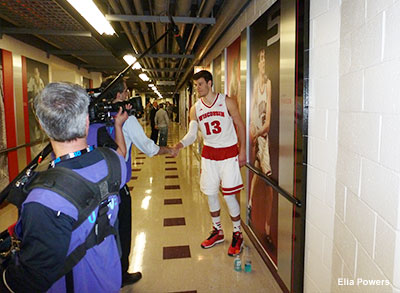
Friedman started at BTN less than two months before its launch on August 30, 2007. Programming in the early days largely consisted of live game coverage and studio shows. Friedman, coordinating producer for BTN Originals, worked with colleagues to launch original programming for the network.
"The Journey: Minnesota Basketball," an eight-episode series that chronicled Tubby Smith's first season with the Gophers, debuted during the 2007-08 season.
"We thought to be there and actually see [Smith] inherit a team and what goes into forming your own culture would be compelling for the viewer," Friedman said. "That was the main reason why we did that show."
Filming began with Midnight Madness and ended after Minnesota's NIT loss to Maryland. The season featured one of the most iconic moments in Big Ten Tournament history -- Minnesota guard Blake Hoffarber's Christian Laettner-like buzzer-beater to beat Indiana.
The first season had a loose structure and no regular time slot. That changed in season two for Illinois Football: The Journey, a show that followed the Illini in 2008, the year after their Rose Bowl appearance. Illinois' roster was filled with NFL talent, but the team underachieved, making for compelling television.
"We saw that there was an appetite for this type of program and not just live events or studio shows," said Michael Calderon, BTN's vice president of programming and digital media. "We're proud of how these seasons turned out but we learned that we were really limiting the appeal of these shows to one fan base."
The Journey went dark in 2009 as Friedman and the production crew reimagined the show. He found inspiration in John Feinstein's "A Season Inside: One Year in College Basketball," a book about a full season of the sport as told through the stories of star players and lesser-known characters.
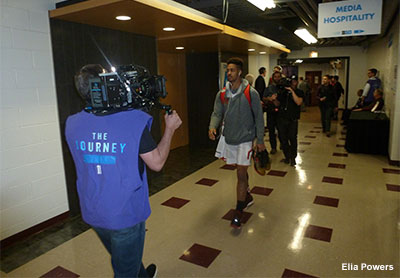
Friedman said he was attracted to the nonlinear narrative and the freedom to cover the stories he wanted.
"I thought to myself, 'Wouldn't it be neat to do something for The Journey similar to that -- look at the Big Ten basketball season and just tell it?'" Friedman said. "It allows you to go to the biggest games and follow the storylines, and gives you a sense that there's more to college basketball than the brand-name coaches and the superstar players. There are other players on the team that have interesting stories to tell."
That was Friedman's pitch to the network. And beginning with the 2009-10 basketball season, each episode of The Journey covered several storylines from campuses across the conference. Evan Turner, the Ohio State phenom who would be selected second in the 2010 NBA draft, was featured prominently in that first rebooted season. Turner hit one of the other most iconic shots in Big Ten Tournament history, a buzzer-beater near half court to beat rival Michigan.
Friedman felt confident from that first season that The Journey had found a winning formula. Now it was a matter of convincing the conference's constituents -- athletic directors, coaches, sports information directors and players -- to let the cameras in.
"I think some schools would agree with me that they were a little skeptical about this at first," Friedman said. "But we just pushed through and said we are going to do this."
Friedman is pacing the hallways at the United Center. Strap a Fitbit to the man on the Friday of Big Ten Tournament week and he'd easily eclipse 30,000 steps.
He's not alone. The rest of The Journey's production crew spend much of the day lugging heavy cameras and boom microphones through a corridor that connects the loading dock to locker rooms. This 50-yard stretch is filled with athletes and coaches; former athletes and coaches turned announcers (hello, Rick Mahorn); beat writers and broadcasting bigshots (there's Jim Nantz checking out the snack bar); trombone players and mascots (always smiling, even after season-ending losses); and halftime show participants chatting up arena security guards.
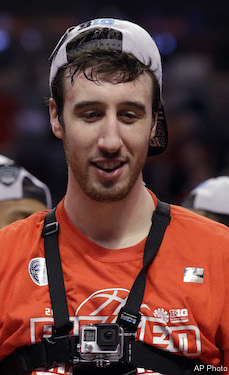
It's just after 9 a.m., two hours before the first quarterfinal game, and the corridor is mostly empty. Friedman has already been here for an hour, and he's coordinating the day's first shot from inside the arena. The Badgers are coming. He knows this because he can see them unloading the bus -- and because he has a spreadsheet on his cell phone that tells him, down to the minute, each team's schedule for the day.
Friedman is stationed at the top of the loading ramp. The production team is in place. Filming top-seeded Wisconsin's arrival on day one is a must for The Journey. At 9:30 a.m., a few players stroll by. Then Badgers coach Bo Ryan. Friedman has his eyes planted on big target a few hundred feet away. Frank Kaminsky's entrance is the shot he's been waiting for. Friedman dispatched a crew to Madison earlier in the week to shoot Kaminsky, the Big Ten Player of the Year and a Naismith College Player of the Year Award frontrunner, for a lead segment of the finale. But this is the footage he needs to make the Kaminsky piece look authentic.
"You get one chance at them," Friedman said as the nation's top center walked by with full-on paparazzi treatment. "There's a lot of hustling followed by long periods of waiting."
The Journey's production team does much of its work in settings just like this, out of view from most television cameras and crowds.
"We try to get things that didn't make the telecast – arrival shots, warmup shots, locker room speeches, tunnel video -- things that the broadcast networks typically don't include on their broadcast but that we can get access to," Friedman said.
Access is no problem at the Big Ten Tournament. The Journey's cameras are typically allowed inside team meetings, locker rooms and huddles. Friedman has spent years building relationships with sports information directors and coaches – the two most important people for him to know at each school. Friedman knows from experience which coaches tend to welcome the cameras, but at the tournament he is constantly checking in with sports information directors about whether he can film pre- and post-game speeches (typically closed to the media).
John Beilein is one of the open ones. Friedman has the green light from the Michigan coach to film pretty much anything in the moments leading up to the Wolverines' quarterfinal game against Wisconsin.
At 9:45 a.m., Beilein and his squad enter United Center. The Journey's cameras follow them around the corner as Friedman waits for what he calls the "Reservoir Dogs" shot -- men walking in a pack, looking tough (the players, at least) and getting hyped before game time.
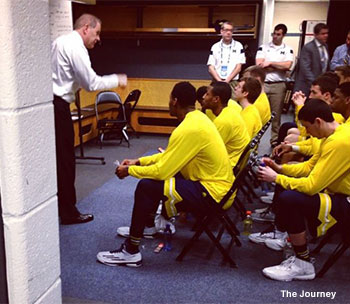
Michigan players unpack their gear in the locker room and head to the court for warmups. With 40 minutes left until game time, everyone piles back in the locker room.
"I want to get Beilein writing on the board," Friedman tells two members of his production team as they enter the locker room.
They are feet away from Beilein and seated Michigan players as the coach challenges his team to outwork Wisconsin. Friedman is snapping photos for The Journey's Instagram account. He smiles as Michigan assistant Bacari Alexander steps to the front of the room. Alexander's prowess for motivational speaking earned him his own slot on a previous episode of The Journey. He doesn't disappoint.
Memorable quotes from the pre-game speeches -- but nothing about the team's game plan -- make the season finale.
"We're trying to give people a sense of who these people are rather than focus on X's and O's," Friedman said.
Added Matt Engel, a producer and cinematographer for BTN: "For the things we capture, the trust has to be there. We understand that you can't show strategy."
Friedman and the production team have met before the game to discuss their own strategy – how to shoot the Wisconsin-Michigan game. The storylines are clear. The Wolverines were depleted by draft defections, finished around .500 and need to win out to make the NCAA tournament. Wisconsin is fighting for a No. 1 seed in the NCAA Tournament. A Big Ten Tournament championship would complement its regular-season title.
Cameras are focused on Kaminsky from warmups and the national anthem through the final buzzer and the handshake line. Michigan and Wisconsin are, in recent years at least, Big Ten basketball royalty. But what about the programs that aren't?
Calderon, BTN's vice president of programming and digital media, looks at The Journey's story selection process as a math puzzle. Not counting the season finale for basketball, which is exclusively focused on the Big Ten Tournament, there are nine episodes per season. With typically three storylines per show, that's 27 segments. There are 14 schools in the conference. While the Big Ten has no mandates about spreading coverage equally among to all members, Friedman has a self-imposed goal: Every school should appear at least once per season. That leaves roughly 13 slots that are unspoken for at the start of each season.
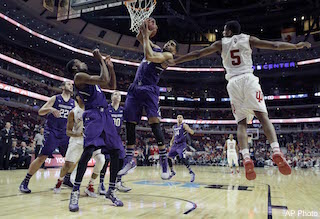
Determining how to fill these slots is a balancing act, Friedman said. He circles a handful of big games at the start of the football and basketball season and knows, for the sake of the show's credibility, The Journey has to attend. Every season there are star players, emerging talents and compelling characters whose stories demand to be told. And sometimes it comes down to programming synergy: the network likes to feature a primetime BTN telecast followed by an episode of The Journey that profiles an athlete involved in the game, Calderon said.
These are the weekly decisions facing the production team from October through mid-March. Friedman thinks several weeks in advance, in large part because coordinating the show involves a web of logistics: trips to campus, negotiations about access and scheduling shoots that allow editors enough time to comb through the footage before deadline.
Basketball, with its fluid game schedule, allows The Journey more leeway to send crews out to practices and games throughout the week. Friedman said that's one reason why the show for several years post-reboot focused exclusively on basketball. The challenge of shooting the football version of The Journey is that games are almost always just one day a week.
Events like the Big Ten Tournament, while exhausting for Friedman and the production team, are in some ways a relief -- all the action plays out in one place during five days. During the Big Ten Tournament, filming wraps up Sunday and the production deadline is early Wednesday. A tournament format provides its own challenges, most notably planning for contingencies.
Friedman didn't plan to shoot much from Thursday's Iowa-Penn State game, but when it becomes evident that Penn State could (and eventually does) pull the upset, he changes his game plan. His Big Ten Tournament mindset: Think ahead and cast a wide net.
The decision to give Dez Wells the trademark round-the-clock treatment on Friday pays dividends, as the Maryland senior guard has a vintage performance (22 rebounds, six rebounds, several acrobatic plays) in a quarterfinal win over Indiana.
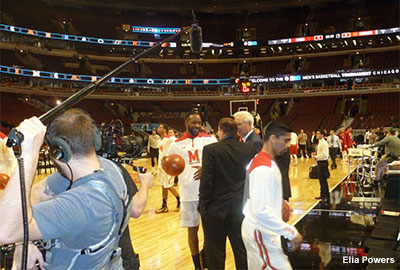
Julian Darnell, a senior features producer for BTN who has his eyes on Wells and Maryland point guard Melo Trimble for much of the game, offers his analysis as he walks back to the press dining room: "It isn't like Melo isn't a good story, but Dez is the story."
Five days later, Wells is one of the lead stories on The Journey's season finale. From hours of footage, editors cut a short package on Wells' first-ever game playing at United Center, former home court of his childhood idol Michael Jordan. The piece's visual climax: A clip of Wells brushing his hand across wall art of Jordan in the hallway outside the locker room.
Another mini-package focuses on Purdue, the conference's most compelling turnaround story. Samantha Eisenberg, a feature producer for BTN Originals, followed the Boilermakers as they prepared for the Big Ten Tournament. The all-access piece featured Purdue eating a team meal and practicing at the Bulls' training facility, and coach Matt Painter scouting his team's possible quarterfinal opponents.
"Coaches begin to trust you to see their preparation," said Eisenberg, who set up the shots, conducted interviews and edited the piece. "We were there when [the Boilermakers] found out they were playing Penn State."
They were also there when the Badgers cut the net on Sunday and earned a top seed in the NCAA Tournament several minutes after their championship celebration ended.
A matchup of two eventual Final Four teams in the Big Ten Tournament championship game closed out The Journey's season finale. But Wisconsin-Michigan State game footage was only part of the piece.

"Nobody is watching our show to find out who won or lost the game," Friedman said.
People watch for the access and because they want to know what the athletes and coaches they follow are like behind the scenes.
"To me what sets The Journey apart is the ability to tell a story," Calderon said. "Most of the stories we tell are human-interest stories more than they are athletic stories."
Some of these features are what Friedman calls "connection stories" -- two high school or AAU teammates reuniting for a Big Ten game. Others are "off-the-beaten-path" stories – the longtime voice of the Indiana Hoosiers or Ohio State's self-proclaimed "club trillion" bench warmers whose stat lines read 1 (for minutes played) followed by a host of zeros.
The Journey is perhaps best known for yet another category of human-interest story: the heart-warmer. See the viral (more than 2 million YouTube hits) 2012 piece about the reunion of then-Illinois center Meyers Leonard and his Marines brother who watched him play in a college game for the first time. Or several pieces on the close bond between former Michigan State forward Adreian Payne and Lacey Holsworth, a young girl who developed and eventually died of cancer. Friedman heard about this story from Michigan State's sports information director at basketball media day. Eisenberg developed a relationship with Holsworth's family and produced the piece during the 2012-13 season.
The show revisited the storyline again on Payne's senior night, when Holsworth carried a bouquet and walked arm-in-arm with Payne to the center of MSU's court.
"When Adreian gets introduced and they are just waiting in the tunnel and Lacey steals a glance at Adreian, that's s real powerful shot," Friedman said.
Darnell, the senior features producer, said one of his favorite parts of working on The Journey is that "all of our characters become recurring characters."

That's true of D.J. Newbill. For three years Eisenberg had her eye on profiling the Penn State guard, whose mother died before he played his first game for the Nittany Lions. Finally this year, Newbill was ready to tell his story. Eisenberg kept an eye on Newbill and Penn State as they advanced for two rounds in the Big Ten Tournament.
"The fact that they are making a run when people thought they would lose the first game, it's a perfect story," Eisenberg said on the Friday of tournament week from BTN's spacious office in downtown Chicago.
But as Penn State's long-shot bid to win five games in five days finally ended Friday with its loss to Purdue, Eisenberg watched closely as Newbill sobbed on the court. The Journey held on that shot -- and Newbill's long walk to the locker room -- for 90 seconds.
That's consistent with the philosophy of the show's editors.
"We try to get the emotion of the game -- not just the highlights," said Daniel Leigh, a senior editor with BTN.
Editors look for shots they would never include during a highlight package, like a player getting into a defensive stance or a coach signaling for his team to press. They look for crowd reaction, like Frank Kaminsky's father fist pumping after his son's spin move, and colorful fans, like Maryland students dressed like coach Mark Turgeon who held a sign that was an olive branch to Big Ten fans and a jab at the ACC: "Chicago > Greensboro."
Editors build tension through a combination of music and pacing. The Journey's theme song, written by Alec Puro and played during the show's opener, sets the dramatic tone for the show. Slow-motion close-ups of coaches, athletes and fans are another trademark.
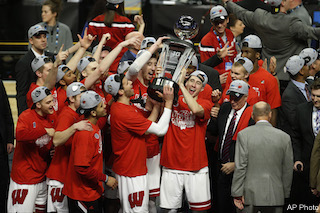
"The cinematography makes it feel bigger," said John Castelli, BTN's senior editor for original programming. "It might be a great shot or key moment of the game. We'll figure out how to slow it down. I love letting a shot play out for 25 seconds."
With swelling music and visual effects, The Journey can make a midweek, midseason game between two unranked teams feel like the conference championship game in much the same way that NFL Films did decades ago.
As cameramen film games and editors watch them from BTN's office, they typically listen live to local radio broadcasts. Because the show doesn't use a narrator, an announcer's call often helps tell the story.
"When there's a great call on radio and a great reaction [on tape], we want to hold on that," Leigh said.
The editors, Castelli said, feed off emotions. Like Newbill's tears. Or Kaminsky's smile.
















